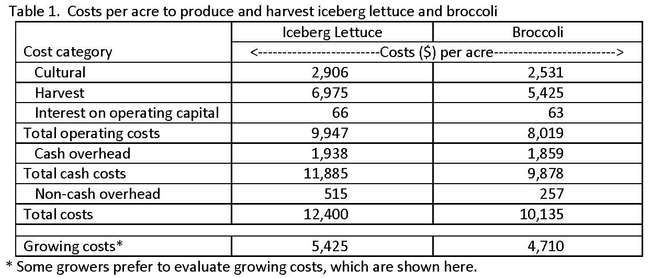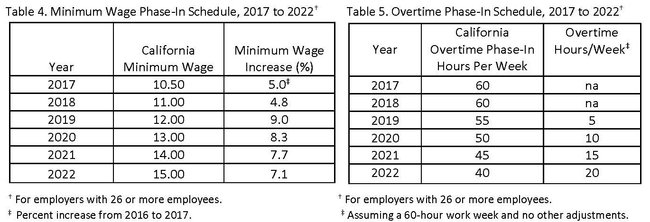Studies that examine crop production and harvest costs, as well as capital costs and net returns, can be helpful to growers in making production decisions, preparing budgets, and evaluating production loans. Cost and return analyses can also assist growers in considering risk and in determining the potential profitability of a crop. Two recently completed studies estimating costs and returns for Central Coast wrapped iceberg lettuce and fresh market bunched broccoli are now available at https://coststudies.ucdavis.edu. Titled Sample Costs to Produce and Harvest Iceberg Lettuce 2017 and Sample Costs to Produce and Harvest Broccoli 2017, these studies were a collaborative effort that included UC Cooperative Extension farm advisors, local growers and industry, and UC Agricultural Issues Center economists and researchers.
Each study begins with a narrative that describes how the costs and returns were calculated. Following this text, an in-depth analysis of the estimated production and harvest costs are presented in a series of tables. Per acre costs are shown for land preparation, fertilization and pest management practices, and material inputs and labor, all of which fall under the category cultural costs. Harvest practices and costs are also detailed. Cash or business overhead costs are estimated, and include items such as land rent, insurance, food safety and regulatory programs. Finally, non-cash or investment costs are discussed and included in each study. Table 1 summarizes per acre costs for iceberg lettuce and broccoli. Greater detail on the sequence of operations and costs contained in each broad cgory can be found in the studies.
Monthly cash cost tables are presented in each study, which can be helpful in managing cash flow and understanding when production loans may be needed. In addition, the tables can be used to evaluate months with peak labor demands and assist with scheduling.
A ranging analysis is also included in each study, which estimates net returns per acre above operating, cash, and total costs for several alternative yield and price combinations. For lettuce, net returns are calculated for yields ranging from 600 to 1,200 cartons per acre (24 film wrapped heads weighing 42 pounds) and prices ranging from $9 to $17 per carton. For broccoli, net returns are estimated using a yield range of 550 to 850 cartons per acre (14 bunches weighing 21 pounds) and prices ranging from $8 to $13.10 per carton. Tables 2 and 3 below contain a selection of the estimated net returns above total costs for lettuce and broccoli.
At the lower yields and prices for iceberg lettuce (table 2), growers operate at a net loss per acre. As yields and prices improve, however, there is potential for a modest positive net return per acre. Growers of bunched broccoli operate at a net loss per acre regardless of yield or price scenario (table 3). The loss is smaller as yields and prices improve. Though net returns to growers can vary substantially from crop to crop and depend on many production and market conditions, the results from both studies—most notably for bunched broccoli—show that there is currently substantial pressure for growers to increase net returns. To improve profitability, growers may use different pack types and market strategies. High labor costs and low product prices, at least in part, help explain the results shown here. An expanded analysis can be found in each study.
Although technology has begun to play a larger role in the production and harvest of fresh market crops than it has in the past, a reliable and productive labor force is still critical to bring a crop to market. Labor costs are discussed and calculated for each crop, with hourly wages set at $21.85 for equipment operators, $17.80 for irrigators, and $16.90 for field workers. These rates include overhead costs of 41 percent. Irrigation, weed management, and harvest are prominent “high cost” labor practices.
New minimum wage and overtime laws that were passed in California in 2016 will have significant implications for agriculture. Although wage rates used in the studies are already higher than the minimum wage shown below for 2017, tables 4 and 5 provide information on the phase-in schedules for the new laws.
As table 4 indicates, minimum wage will steadily increase each year, reaching a $15 base wage per hour by 2022. Table 5 shows that the overtime law will gradually decrease the number of hours employees can work on a weekly basis before overtime wages are required. Prior to its passage agricultural workers could work up to 10 hours per day or 60 hours per week without overtime wages; by 2022 the requirement will be lowered to 8 hours per day or 40 hours per week for employers with 26 or more employees. The overtime law may change wages and scheduling of work in complicated ways as it is phased in.
The full impact of the two new laws on prevailing agricultural wages is not yet clear. But the studies recognize that growers may already pay wages that are different than those used to calculate the lettuce and broccoli costs, and that agricultural wages are currently in flux. The studies also note that growers may choose to use a farm labor contractor or the H-2A guest worker visa program to employ workers and assure a reliable supply of labor.
Vegetable and other cost and return studies for this area, and for other regions in California, are updated periodically, and are always available at https://coststudies.ucdavis.edu. Questions about these or other studies can be directed to either Laura Tourte or Richard Smith at UC Cooperative Extension.



